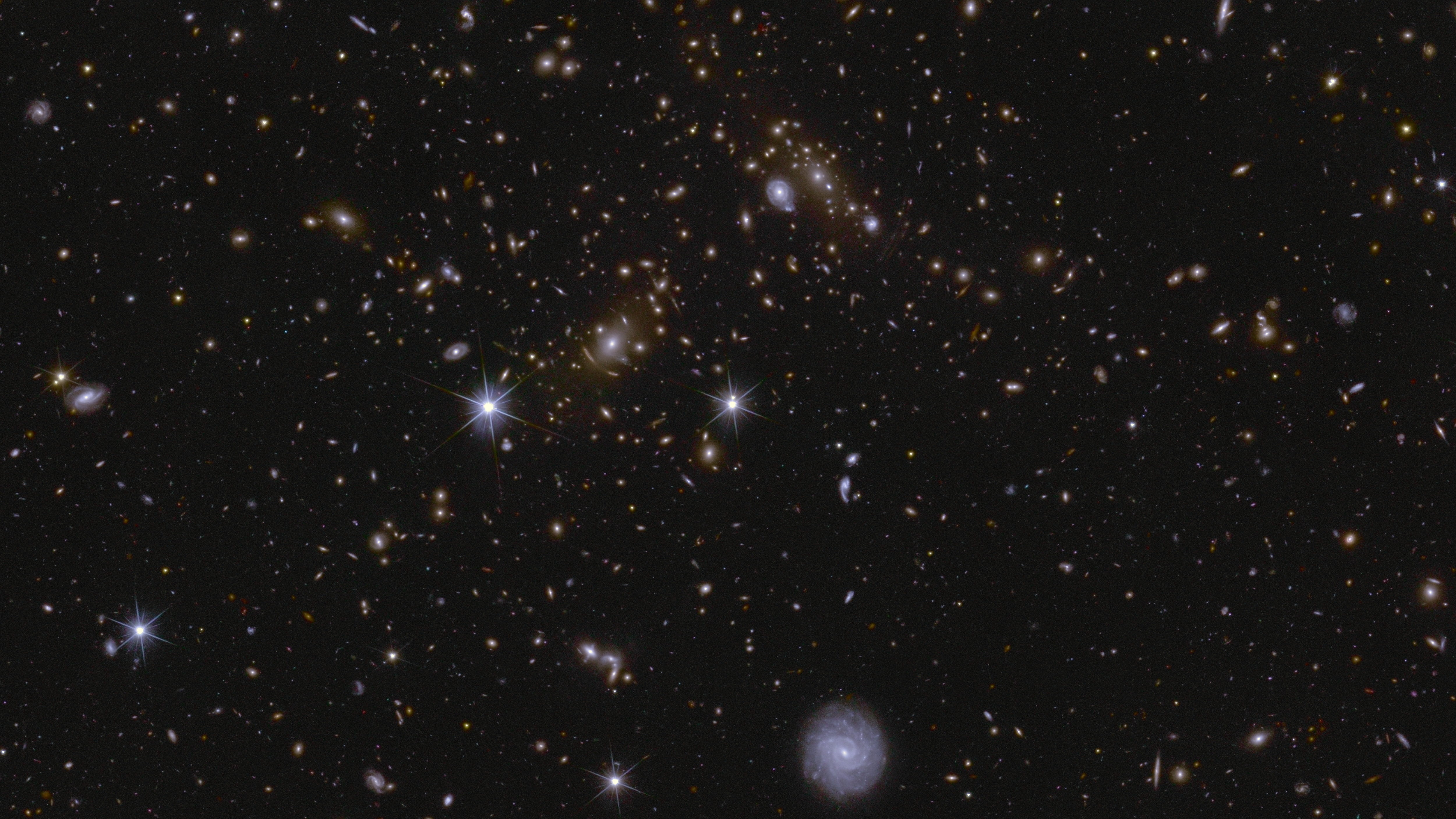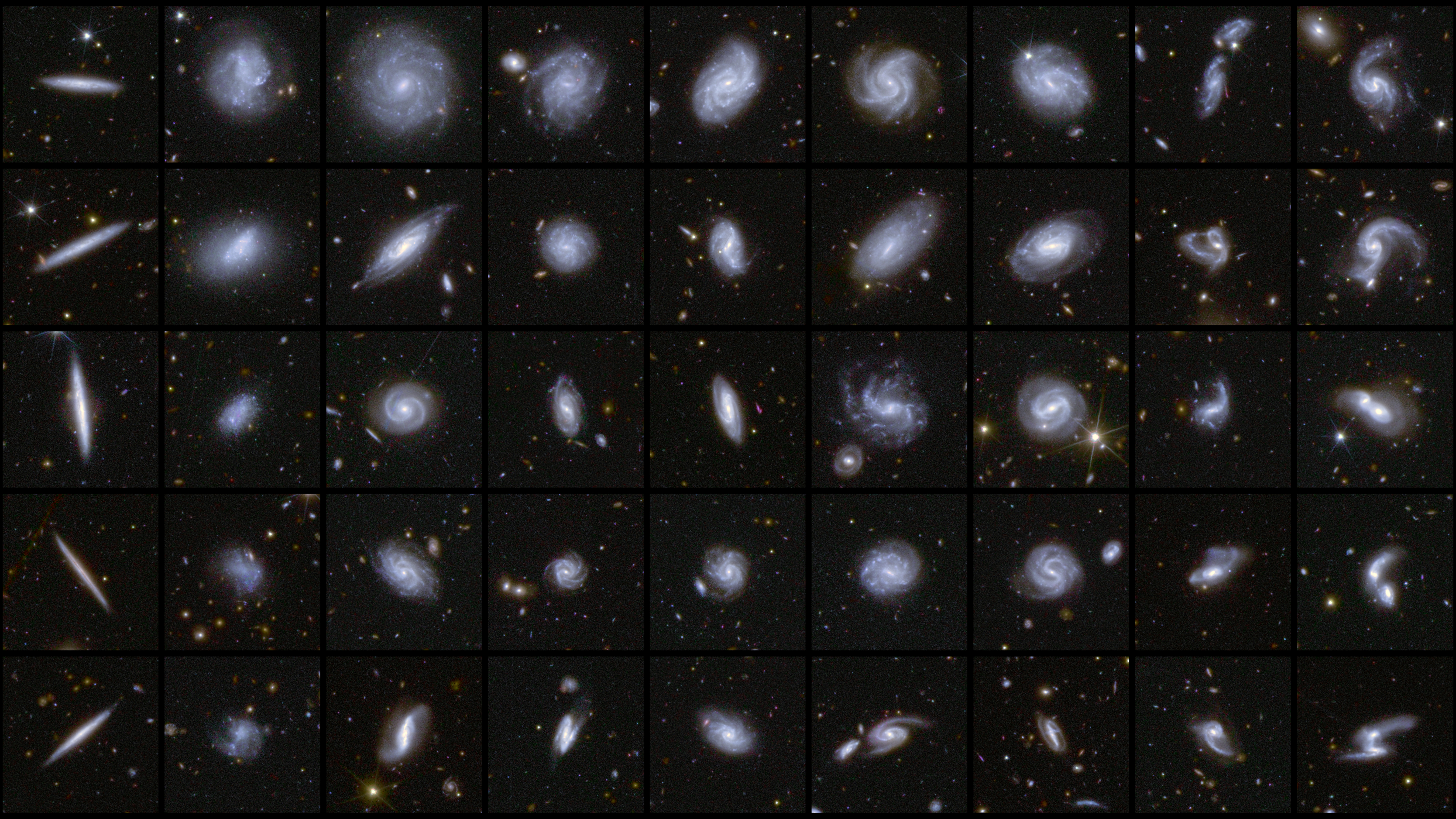A team of researchers from the Institute of Physics of Cantabria participates in the analysis of key data on galaxy evolution and dark matter.
The Euclid mission of the European Space Agency publishes the first batch of data from its survey, including a preview of its deep fields.
Euclid completes its scientific results using artificial intelligence algorithms and citizen science campaigns.

The South Deep Field region of Euclid, where several massive galaxy clusters, intracluster light, and gravitational lenses can be seen. / ESA/Euclid/Euclid Consortium/NASA, image processing by J.-C. Cuillandre, E. Bertin, G. Anselmi.
Santander, March 19, 2025
The Institute of Physics of Cantabria (IFCA, CSIC-UC) has played a key role in the recent findings of the Euclid mission, an ambitious international project led by the European Space Agency (ESA) over the past six years to map the universe and unravel the mysteries of dark matter and dark energy—two of the biggest enigmas in 21st-century physics.
This marks the first batch of data extracted from the cosmic survey, including hundreds of thousands of galaxies of various shapes and sizes, providing insights into their large-scale organization within the cosmic web. These galaxies, observed and analyzed by the scientific team of the Euclid Consortium, demonstrate the power of this telescope, which is designed to deliver the most precise map of our universe over time. The results have been published in 27 scientific papers, along with 7 additional articles describing the data processing, all of which were released today on ArXiv.
The sky survey has been divided into three mosaic sections, revealing galaxy clusters—some of the oldest in the universe—active galactic nuclei (AGN), and the first classification of more than 380,000 galaxies and 500 gravitational lens candidates (previously, only about 150 had been observed). These findings, supported by artificial intelligence and citizen science campaigns, will contribute to a better understanding of dark matter distribution.

A detailed catalog of more than 380,000 galaxies has been compiled, classified according to characteristics such as spiral arms, central bars, and tidal tails. / ESA/Euclid/Euclid Consortium/NASA, image processing by M. Walmsley, M. Huertas-Company, J.-C. Cuillandre.
IFCA's role in Euclid mission
Researchers from IFCA's Cosmology group, José M. Diego, Ana Acebrón, Sefa Pamuk, and Helena Domínguez, members of the Euclid Consortium, have participated in analyzing the data published in Quick Release 1 (Q1), which covers 63 square degrees of the sky, representing 0.45% of the total sky Euclid will capture during its mission.
The IFCA team has focused on analyzing data related to gravitational lensing and the formation of cosmic structures, one of the most powerful tools for studying dark matter. Researcher José M. Diego, an expert in this phenomenon, highlights that "the resolution and volume of Euclid's data allow us to discover gravitational lensing systems in unprecedented detail, improving our estimates of dark matter distribution in the universe."
Meanwhile, researchers Ana Acebrón and Helena Domínguez have studied galaxy morphology and evolution, analyzing how their structure and properties change over billions of years. This work is essential for comparing real data with theoretical models and simulations.
Ana Acebrón, co-author of several papers, played a crucial role in identifying the first galaxy clusters with strong gravitational lensing effects in Q1 observations, covering 63.1 square degrees. She also co-led the Key Project, coordinating an international team of researchers who visually inspected 1,260 galaxy clusters. "Thanks to this effort, we have identified 83 gravitational lens candidates, 80 of which had never been observed from space. These initial results suggest that Euclid will detect more than 4,500 gravitational lensing clusters throughout its mission," says Acebrón.
Cosmology researcher Helena Domínguez has contributed to studies exploring the relationship between galaxy morphology, mass, star formation rate, and their evolution over cosmic time. "Morphological classification relied on traditional methods, such as fitting models to galaxy luminosity profiles, as well as supervised and unsupervised artificial intelligence algorithms," explains Domínguez. She has also collaborated on gravitational lens detection using AI models.
"I have worked on the more theoretical side of Euclid, developing sophisticated mathematical models to predict the large-scale structure of the universe. Specifically, I studied the impact of neutrinos on the distribution of matter and galaxy evolution. We know from previous experiments that there are three types of neutrinos, each with a tiny mass, and Euclid is expected to measure the sum of these masses. This is particularly exciting because the mechanism by which these particles acquire their mass remains unknown. Personally, I find this thrilling, as it sheds light on one of modern physics' greatest unanswered questions," explains IFCA researcher Sefa Pamuk.
Reconstructing the ‘cosmic web’
Thanks to Euclid, the scientific team has successfully reconstructed what is known as the cosmic web, an enormous structure of galaxy filaments that reveals how matter is organized in the cosmos. The so-called Q1 fields illustrate what scientists will analyze to map the large-scale structure of the universe over cosmic time and investigate the nature of dark matter and dark energy in the coming years. Covering approximately 63 square degrees of the sky, more than 300 times the area of the full Moon, these observations represent the largest contiguous sky regions ever observed with an optical and near-infrared space telescope.
Additionally, Euclid has revolutionized the study of active galactic nuclei (AGN), periods of intense activity in supermassive black holes at the centers of galaxies. Using artificial intelligence, thousands of new red quasars have been cataloged, providing insights into the connection between galaxy mergers and the evolution of these extreme objects.
Artificial intelligence and Zooniverse, a citizen science platform
Euclid is expected to capture images of more than 1.5 billion galaxies over six years, transmitting around 100 GB of data daily. Such a vast dataset presents opportunities for new discoveries but also significant challenges in searching, analyzing, and cataloging galaxies. The advancement of artificial intelligence (AI), combined with thousands of volunteers in citizen science projects organized by Euclid, plays a fundamental role.
One example is Euclid’s first citizen science campaign, launched in August 2024 on the Zooniverse platform, where millions of volunteers classified thousands of galaxies, helping train the supervised learning algorithm.
The resulting catalog is based on 0.45% of the 100 million galaxies Euclid will capture in detail. Additionally, thanks to this high-quality dataset, differences have been observed between real galaxies and simulated ones.
The next steps in the mission include publishing additional datasets and beginning a detailed mapping of the universe to study dark energy, with new opportunities for the IFCA team to continue contributing to cosmic exploration.
About Euclid
Euclid is a European mission, built and operated by ESA, with contributions from NASA. The Euclid Consortium, consisting of more than 2,000 scientists from 300 institutes across 15 European countries, as well as the U.S., Canada, and Japan, is responsible for providing the scientific instruments and analyzing the scientific data. Euclid is a medium-class mission in ESA’s Cosmic Vision Program. Additionally, around 80 European companies participate in Euclid, including 9 Spanish firms such as Airbus, Alter Technology, Crisa, Deimos Space, GTD, Navair, Sener, and Thales Alenia Space España.
The Euclid Consortium’s scientific papers are now available and can be accessed on the mission’s official website and ArXiv.
The three deep field previews can now be explored in ESASky:
- Euclid Deep Field South
- Euclid Deep Field Fornax
- Euclid Deep Field North
ESA / IFCA / ICE / Communication
